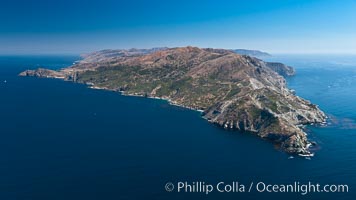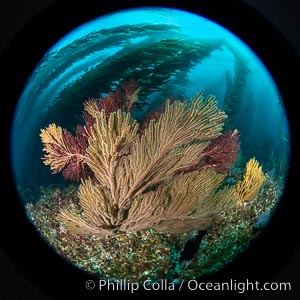
Garibaldi and California golden gorgonian on underwater rocky reef, San Clemente Island. The golden gorgonian is a filter-feeding temperate colonial species that lives on the rocky bottom at depths between 50 to 200 feet deep. Each individual polyp is a distinct animal, together they secrete calcium that forms the structure of the colony. Gorgonians are oriented at right angles to prevailing water currents to capture plankton drifting by.
Species: California golden gorgonian, Giant kelp, Muricea californica, Macrocystis pyrifera
Location: San Clemente Island, California
Image ID: 38509
Species: California golden gorgonian, Giant kelp, Muricea californica, Macrocystis pyrifera
Location: San Clemente Island, California
Image ID: 38509
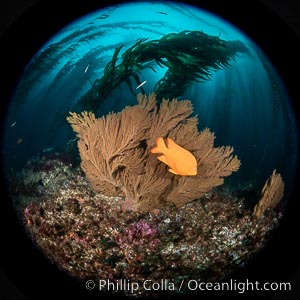
Garibaldi and California golden gorgonian on underwater rocky reef, San Clemente Island. The golden gorgonian is a filter-feeding temperate colonial species that lives on the rocky bottom at depths between 50 to 200 feet deep. Each individual polyp is a distinct animal, together they secrete calcium that forms the structure of the colony. Gorgonians are oriented at right angles to prevailing water currents to capture plankton drifting by.
Species: California golden gorgonian, Giant kelp, Garibaldi, Muricea californica, Macrocystis pyrifera, Hypsypops rubicundus
Location: San Clemente Island, California
Image ID: 38510
Species: California golden gorgonian, Giant kelp, Garibaldi, Muricea californica, Macrocystis pyrifera, Hypsypops rubicundus
Location: San Clemente Island, California
Image ID: 38510
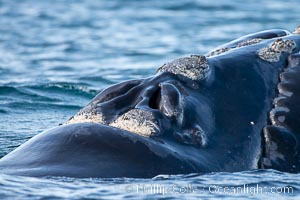
Southern right whale opens blowholes as it breathes at the ocean surface.
Species: Southern Right Whale, Eubalaena australis
Location: Puerto Piramides, Chubut, Argentina
Image ID: 38398
Species: Southern Right Whale, Eubalaena australis
Location: Puerto Piramides, Chubut, Argentina
Image ID: 38398
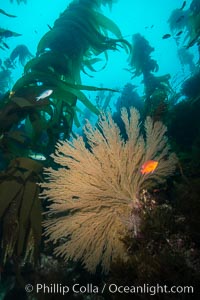
Garibaldi and California golden gorgonian on underwater rocky reef, San Clemente Island. The golden gorgonian is a filter-feeding temperate colonial species that lives on the rocky bottom at depths between 50 to 200 feet deep. Each individual polyp is a distinct animal, together they secrete calcium that forms the structure of the colony. Gorgonians are oriented at right angles to prevailing water currents to capture plankton drifting by.
Species: California golden gorgonian, Garibaldi, Hypsypops rubicundus, Muricea californica
Location: San Clemente Island, California
Image ID: 30864
Species: California golden gorgonian, Garibaldi, Hypsypops rubicundus, Muricea californica
Location: San Clemente Island, California
Image ID: 30864
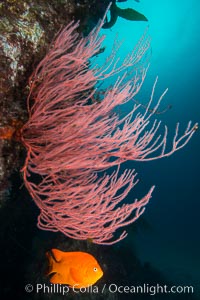
Garibaldi and red gorgonian on rocky reef, below kelp forest, underwater. The red gorgonian is a filter-feeding temperate colonial species that lives on the rocky bottom at depths between 50 to 200 feet deep. Gorgonians are oriented at right angles to prevailing water currents to capture plankton drifting by.
Species: Garibaldi, Red gorgonian, Hypsypops rubicundus, Leptogorgia chilensischilensis, Lophogorgia chilensis
Location: San Clemente Island, California
Image ID: 30870
Species: Garibaldi, Red gorgonian, Hypsypops rubicundus, Leptogorgia chilensischilensis, Lophogorgia chilensis
Location: San Clemente Island, California
Image ID: 30870
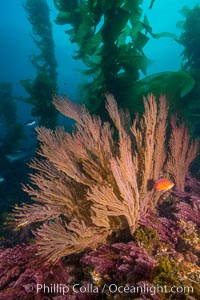
California golden gorgonian on underwater rocky reef below kelp forest, San Clemente Island. The golden gorgonian is a filter-feeding temperate colonial species that lives on the rocky bottom at depths between 50 to 200 feet deep. Each individual polyp is a distinct animal, together they secrete calcium that forms the structure of the colony. Gorgonians are oriented at right angles to prevailing water currents to capture plankton drifting by, San Clemente Island.
Species: California golden gorgonian, Muricea californica
Location: San Clemente Island, California
Image ID: 30909
Species: California golden gorgonian, Muricea californica
Location: San Clemente Island, California
Image ID: 30909
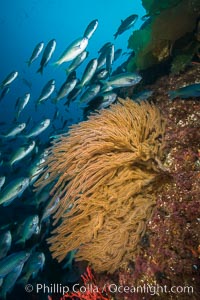
Blacksmith Chromis and California golden gorgonian on underwater rocky reef, San Clemente Island. The golden gorgonian is a filter-feeding temperate colonial species that lives on the rocky bottom at depths between 50 to 200 feet deep. Each individual polyp is a distinct animal, together they secrete calcium that forms the structure of the colony. Gorgonians are oriented at right angles to prevailing water currents to capture plankton drifting by.
Species: Blacksmith, California golden gorgonian, Chromis punctipinnis, Muricea californica
Location: San Clemente Island, California
Image ID: 30956
Species: Blacksmith, California golden gorgonian, Chromis punctipinnis, Muricea californica
Location: San Clemente Island, California
Image ID: 30956
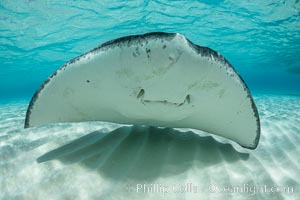
Southern Stingray, Stingray City, Grand Cayman Island.
Species: Southern stingray, Dasyatis americana
Location: Stingray City, Grand Cayman, Cayman Islands
Image ID: 32068
Species: Southern stingray, Dasyatis americana
Location: Stingray City, Grand Cayman, Cayman Islands
Image ID: 32068
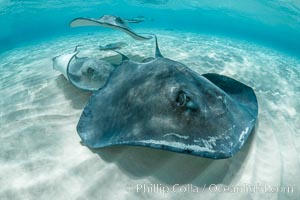
Southern Stingray, Stingray City, Grand Cayman Island.
Species: Southern stingray, Dasyatis americana
Location: Stingray City, Grand Cayman, Cayman Islands
Image ID: 32070
Species: Southern stingray, Dasyatis americana
Location: Stingray City, Grand Cayman, Cayman Islands
Image ID: 32070
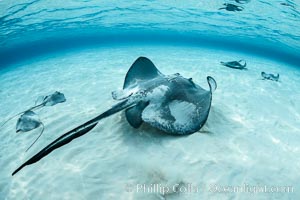
Southern Stingray, Stingray City, Grand Cayman Island.
Species: Southern stingray, Dasyatis americana
Location: Stingray City, Grand Cayman, Cayman Islands
Image ID: 32087
Species: Southern stingray, Dasyatis americana
Location: Stingray City, Grand Cayman, Cayman Islands
Image ID: 32087
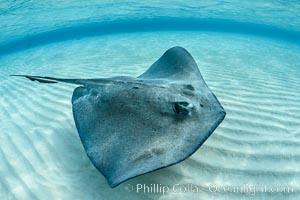
Southern Stingray, Stingray City, Grand Cayman Island.
Species: Southern stingray, Dasyatis americana
Location: Stingray City, Grand Cayman, Cayman Islands
Image ID: 32088
Species: Southern stingray, Dasyatis americana
Location: Stingray City, Grand Cayman, Cayman Islands
Image ID: 32088
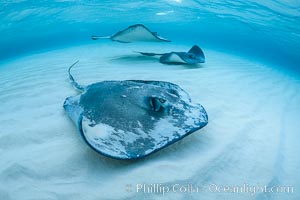
Southern Stingray, Stingray City, Grand Cayman Island.
Species: Southern stingray, Dasyatis americana
Location: Stingray City, Grand Cayman, Cayman Islands
Image ID: 32152
Species: Southern stingray, Dasyatis americana
Location: Stingray City, Grand Cayman, Cayman Islands
Image ID: 32152
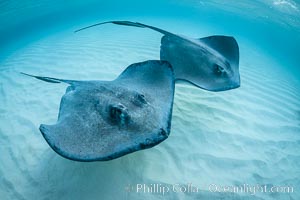
Southern Stingrays, Stingray City, Grand Cayman Island.
Species: Southern stingray, Dasyatis americana
Location: Stingray City, Grand Cayman, Cayman Islands
Image ID: 32158
Species: Southern stingray, Dasyatis americana
Location: Stingray City, Grand Cayman, Cayman Islands
Image ID: 32158
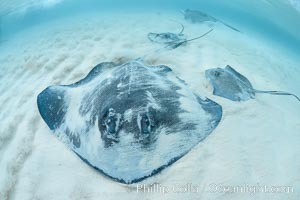
Southern Stingray, Stingray City, Grand Cayman Island.
Species: Southern stingray, Dasyatis americana
Location: Stingray City, Grand Cayman, Cayman Islands
Image ID: 32165
Species: Southern stingray, Dasyatis americana
Location: Stingray City, Grand Cayman, Cayman Islands
Image ID: 32165
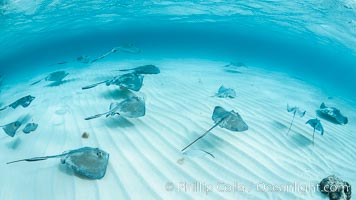
Southern Stingrays, Stingray City, Grand Cayman Island.
Species: Southern stingray, Dasyatis americana
Location: Stingray City, Grand Cayman, Cayman Islands
Image ID: 32169
Species: Southern stingray, Dasyatis americana
Location: Stingray City, Grand Cayman, Cayman Islands
Image ID: 32169
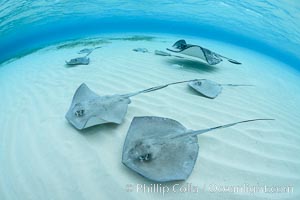
Southern Stingrays, Stingray City, Grand Cayman Island.
Species: Southern stingray, Dasyatis americana
Location: Stingray City, Grand Cayman, Cayman Islands
Image ID: 32209
Species: Southern stingray, Dasyatis americana
Location: Stingray City, Grand Cayman, Cayman Islands
Image ID: 32209
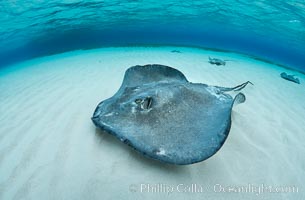
Southern Stingray, Stingray City, Grand Cayman Island.
Species: Southern stingray, Dasyatis americana
Location: Stingray City, Grand Cayman, Cayman Islands
Image ID: 32211
Species: Southern stingray, Dasyatis americana
Location: Stingray City, Grand Cayman, Cayman Islands
Image ID: 32211
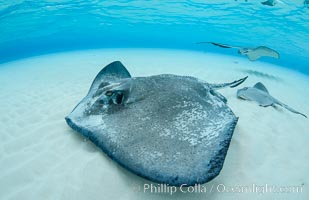
Southern Stingray, Stingray City, Grand Cayman Island.
Species: Southern stingray, Dasyatis americana
Location: Stingray City, Grand Cayman, Cayman Islands
Image ID: 32214
Species: Southern stingray, Dasyatis americana
Location: Stingray City, Grand Cayman, Cayman Islands
Image ID: 32214
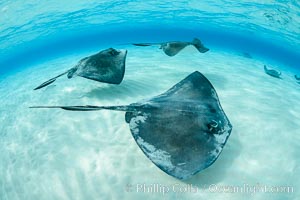
Southern Stingrays, Stingray City, Grand Cayman Island.
Species: Southern stingray, Dasyatis americana
Location: Stingray City, Grand Cayman, Cayman Islands
Image ID: 32215
Species: Southern stingray, Dasyatis americana
Location: Stingray City, Grand Cayman, Cayman Islands
Image ID: 32215
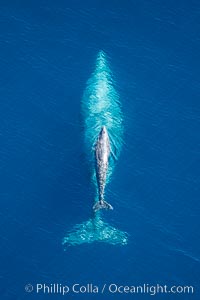
Aerial photo of gray whale calf and mother. This baby gray whale was born during the southern migration, far to the north of the Mexican lagoons of Baja California where most gray whale births take place.
Species: Gray whale, Eschrichtius robustus
Location: San Clemente, California
Image ID: 29001
Species: Gray whale, Eschrichtius robustus
Location: San Clemente, California
Image ID: 29001
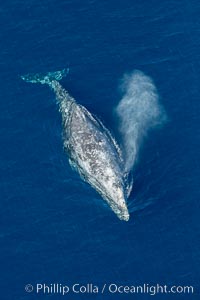
Gray whale blowing at the ocean surface, exhaling and breathing as it prepares to dive underwater.
Species: Gray whale, Eschrichtius robustus
Location: Encinitas, California
Image ID: 29045
Species: Gray whale, Eschrichtius robustus
Location: Encinitas, California
Image ID: 29045
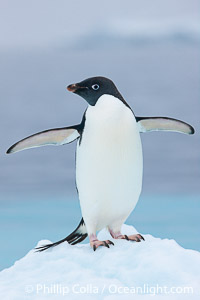
Adelie penguin on an iceberg.
Species: Adelie penguin, Pygoscelis adeliae
Location: Brown Bluff, Antarctic Peninsula, Antarctica
Image ID: 25006
Species: Adelie penguin, Pygoscelis adeliae
Location: Brown Bluff, Antarctic Peninsula, Antarctica
Image ID: 25006
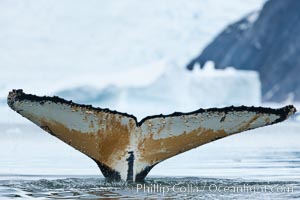
Southern humpback whale in Antarctica, with significant diatomaceous growth (brown) on the underside of its fluke, lifting its fluke before diving in Neko Harbor, Antarctica.
Species: Humpback whale, Megaptera novaeangliae
Location: Neko Harbor, Antarctic Peninsula, Antarctica
Image ID: 25647
Species: Humpback whale, Megaptera novaeangliae
Location: Neko Harbor, Antarctic Peninsula, Antarctica
Image ID: 25647
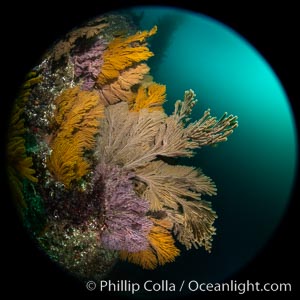
Brown gorgonian and California golden gorgonian on underwater rocky reef below kelp forest, Catalina Island. Gorgonians are filter-feeding temperate colonial species that lives on the rocky bottom at depths between 50 to 200 feet deep. Each individual polyp is a distinct animal, together they secrete calcium that forms the structure of the colony. Gorgonians are oriented at right angles to prevailing water currents to capture plankton drifting by.
Species: Brown gorgonian, California golden gorgonian, Muricea californica, Muricea fruticosa
Location: Catalina Island, California
Image ID: 37292
Species: Brown gorgonian, California golden gorgonian, Muricea californica, Muricea fruticosa
Location: Catalina Island, California
Image ID: 37292
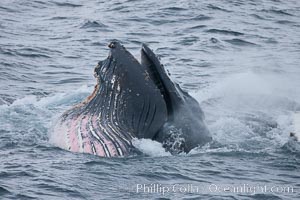
Humpback whale lunge feeding on Antarctic krill, with mouth open and baleen visible. The humbpack's pink throat grooves are seen as its pleated throat becomes fully distended as the whale fills its mouth with krill and water. The water will be pushed out, while the baleen strains and retains the small krill.
Species: Humpback whale, Megaptera novaeangliae
Location: Gerlache Strait, Antarctic Peninsula, Antarctica
Image ID: 25660
Species: Humpback whale, Megaptera novaeangliae
Location: Gerlache Strait, Antarctic Peninsula, Antarctica
Image ID: 25660
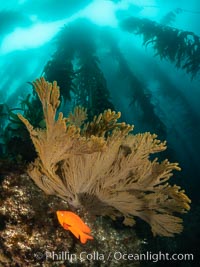
Garibaldi and golden gorgonian, with a underwater forest of giant kelp rising in the background, underwater.
Species: California golden gorgonian, Garibaldi, Hypsypops rubicundus, Muricea californica
Location: San Clemente Island, California
Image ID: 37097
Species: California golden gorgonian, Garibaldi, Hypsypops rubicundus, Muricea californica
Location: San Clemente Island, California
Image ID: 37097
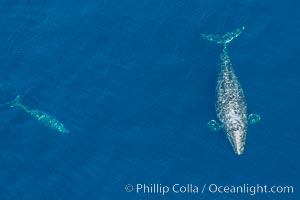
Aerial photo of gray whale calf and mother. This baby gray whale was born during the southern migration, far to the north of the Mexican lagoons of Baja California where most gray whale births take place.
Species: Gray whale, Eschrichtius robustus
Location: San Clemente, California
Image ID: 29031
Species: Gray whale, Eschrichtius robustus
Location: San Clemente, California
Image ID: 29031
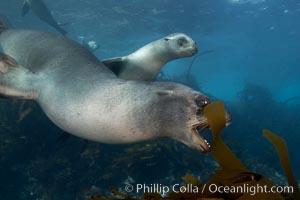
A California sea lion plays with a piece of kelp, underwater at Santa Barbara Island. Santa Barbara Island, 38 miles off the coast of southern California, is part of the Channel Islands National Marine Sanctuary and Channel Islands National Park. It is home to a large population of sea lions.
Species: California sea lion, Zalophus californianus
Location: Santa Barbara Island, California
Image ID: 23427
Species: California sea lion, Zalophus californianus
Location: Santa Barbara Island, California
Image ID: 23427
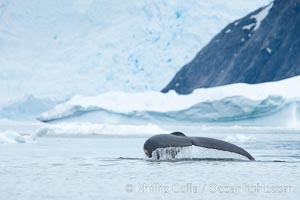
Humpback whale in Antarctica. A humpback whale swims through the beautiful ice-filled waters of Neko Harbor, Antarctic Peninsula, Antarctica.
Species: Humpback whale, Megaptera novaeangliae
Location: Neko Harbor, Antarctic Peninsula, Antarctica
Image ID: 25652
Species: Humpback whale, Megaptera novaeangliae
Location: Neko Harbor, Antarctic Peninsula, Antarctica
Image ID: 25652
